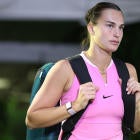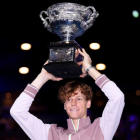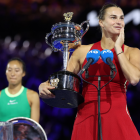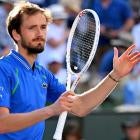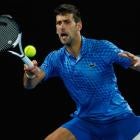His clay-court prowess as unassailable as ever, Rafael Nadal won his record 10th French Open title by dominating 2015 champion Stan Wawrinka 6-2, 6-3, 6-1 in the final Sunday. No other man or woman has won 10 championships at the same major in the Open era, which began in 1968. Call it a Perfect 10.
The 31-year-old Nadal was overwhelmingly good from start to finish against Wawrinka -- and over the past two weeks en route to La Decima, Spanish for "10th." Not only did Nadal win every set he played in the tournament, he dropped a total of only 35 games, the second fewest by any man on the way to any title at a Grand Slam tournament in the Open era with all matches being best-of-five-sets.
Rafa Nadal lost a total of 34 games in six matches at the French Open ... Ridiculous.
— Joe Posnanski (@JPosnanski) June 11, 2017
Along with improving to 10-0 in finals at Roland Garros, Nadal increased his career haul to 15 Grand Slam trophies, breaking a tie with Pete Sampras for second place in the history of men's tennis, behind only rival Roger Federer's 18. It marked a stirring return to the top for Nadal at his preferred event and on his preferred surface: Over his career, he is 79-2 at the French Open and 102-2 in all best-of-five-set matches on clay.
"I play my best at all events, but the feeling here is impossible to describe. It's impossible to compare it to another place," Nadal said. "The nerves, the adrenaline, I feel on the court are impossible to compare to another feeling. This is the most important event in my career."
A year ago in Paris, Nadal surprisingly withdrew before the third round because of a wrist injury, making the announcement at a news conference while wearing a blue brace on his left arm and a look of resignation of his face. He couldn't bring himself to watch much of the rest of the 2016 French Open, he said, other than some doubles matches involving a good pal, and the singles final.
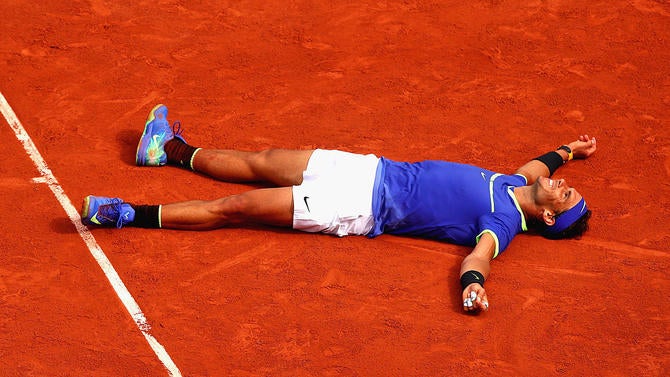
Finally back to full strength in the offseason, Nadal returned to work, reconstructing his forehand and redoubling his efforts to get back to his best. Well, he sure proved to be precisely that Sunday, when the conditions were exactly to the liking of a guy who grew up on the island of Mallorca. The sun was shining, there was barely a trace of cloud in the bright blue sky and the temperature was about 85 degrees (30 Celsius).
Wawrinka is no slouch; he owns three major titles, including one from Roland Garros, and had never lost a Grand Slam final. But a five-set semifinal win Friday over No. 1-ranked Andy Murray must have taken something out of the 32-year-old from Switzerland, the oldest French Open finalist since 1973. His shots didn't have their usual verve, his legs their usual spring.
After one point Sunday, Wawrinka bent over, leaning one arm on his racket and resting the other on a knee. When he netted a forehand to close a 14-stroke back-and-forth in the second set, he pounded his strings on his head several times. Later, he spiked his racket, then mangled it by breaking it over his knee, drawing a warning from the chair umpire.
2017 French Open Men's Final Rafa Nadal vs Stan Wawrinka. Stan brakes his raquet in frustration after losing the first 2 sets 6-2, 6-3. pic.twitter.com/sbepjN5ZZz
— Mo Tafolla (@MoTafolla) June 11, 2017
Instead of pointing to his right temple, as he often does after key points won, Wawrinka kept rubbing his forehead or running his fingers through his hard after key points lost. When he netted a forehand to close a 14-stroke back-and-forth in the second set, he pounded his strings on his head several times.
Nadal has that way of wearing down opponents, physically and mentally. On this day, he was terrific. He won all 12 service games, made a mere 12 unforced errors, and won 94 total points to Wawrinka's 57. He also took the will to fight away from Wawrinka with shots like this.
When you're not even looking but you hit an amazing winner...
— Roland-Garros (@rolandgarros) June 11, 2017
Un peu de magie ? C'est parti ! #RG17 pic.twitter.com/4bZuEVVTbS
When it ended, Nadal dropped to his back on the clay, then rose and briefly pulled his blue shirt over his face. He was again the champion, again unbeatable at the French Open. Nadal is no longer the 19-year-old he was when he won his first French Open title in his tournament debut in 2005, wearing long white pirate shorts, his flowing locks wrapped by a white headband, his sleeveless shirt revealing bulging biceps. The shorts are shorter, the hair more closely cropped, the shirt has sleeves. But his game? Somehow, better.
Nadal also won Roland Garros in 2006, 2007 and 2008, then after a fourth-round loss on bad knees in 2009, he grabbed a record five in a row from 2010-14. A quarterfinal loss in 2015 ended that run, then came last year's injury.
His return to a final in Paris was a meeting of two of the most respected shots in the men's game: Nadal's spin-heavy, high-bouncing uppercut of a forehand vs. Wawrinka's one-handed, power-packed backhand, delivered with such force that the thud of racket-meets-ball sounds like a leather-bound encyclopedia volume -- remember those? -- being dropped on a wood desk.
So Nadal stayed away from that side early, going instead after Wawrinka's forehand. It worked: Of the first seven points won by Nadal, six ended with missed forehands by Wawrinka.
One area of significant improvement for Nadal over the years is his serve. Once passable, it is now potent. So when confronted with the first break point for either man, 10 minutes in, he solved the predicament this way: service winner at 107 mph (173 kph), ace at 117 mph (189 kph), service winner at 120 mph (194 kph). Wawrinka would never see another break chance.
When the ball was in play, Nadal barely missed at all. His groundstrokes were delivered with loud, long grunts, echoing in the otherwise mostly silent Court Philippe Chatrier, filled with 15,000 or so souls too rapt to speak. They let out a burst of claps and roars in the second set on one particularly exquisite display: Wawrinka smacked a cross-court backhand to a corner, and Nadal sprinted to his left to get to the ball, wide of the doubles alley, and whip a forehand that curved around the net post and landed near a line for a winner.
Even Wawrinka applauded that one.
"Nothing to say about today," Wawrinka told Nadal during the trophy ceremony. "You were too good."
Nadal at French Open
— Jordan Sollof (@JordanSollof9) June 11, 2017
2005 🏆
2006 🏆
2007 🏆
2008 🏆
2010 🏆
2011 🏆
2012 🏆
2013 🏆
2014 🏆
2017 🏆
AMAZING
In Saturday's women's final, unseeded Jelena Ostapenko of Latvia used bold strokes and an unbending will to come back and stun No. 3 Simona Halep 4-6, 6-4, 6-3 in an enthralling French Open final for the first title of her career.
Ostapenko, ranked only 47th and just two days past her 20th birthday, became one of the most unlikely Grand Slam champions in tennis history. She also denied Halep what would have been her first major championship and the No. 1 ranking.
"I still can't believe I won," Ostapenko told the crowd at Court Philippe Chatrier. "It was always my dream, when I was a child I was watching players here. I'm just so happy. I've just enjoyed it so much. I have no words."
Halep appeared on the way to a relative runaway victory, leading by a set and 3-0 in the second, then holding three break points for the chance to go ahead 4-0. But Ostapenko would not go quietly, winning that game and the next three en route to forcing a third set.
And then, in the third, Ostapenko again summoned a veteran's resolve, taking the last five games after being down a break at 3-1. She took advantage of a bit of luck, too, holding for a 5-3 lead when she hit a backhand that clipped the top of the net, popped way up in the air, then dropped over onto Halep's side.
Soon enough, Ostapenko was striking two more winners on the final two points to provide a fitting conclusion.
"All the credit for what you've done. It's an amazing thing. Enjoy, be happy, and keep it going," Halep told Ostapenko, "because you're like a kid."
Sure is. Quite a precocious one.
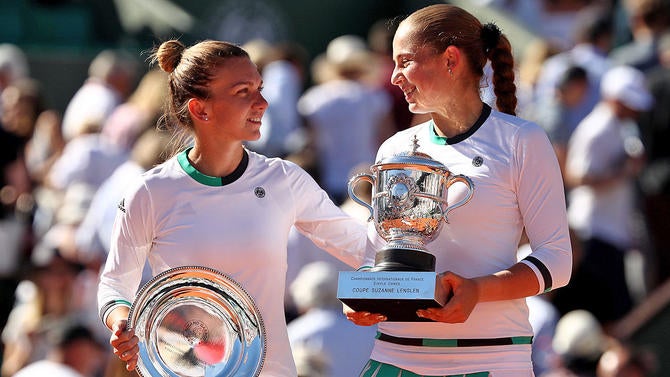
It was a match filled with wild momentum swings between two players displaying completely disparate styles: Ostapenko's grip-it-and-rip-it approach versus Halep's more conservative keep-the-ball-in philosophy. By the end, the numbers were stark: Ostapenko built a 54-8 edge in winners, but she also had far more unforced errors than Halep, 54-10.
Halep, a 25-year-old from Romania, was playing in her second major final. She was the runner-up to Maria Sharapova at Roland Garros in 2014.
"I've been sick in the stomach with emotion," Halep said. "Maybe I was not ready to win it."
Ostapenko was playing in only her eighth Grand Slam tournament, never having been past the third round. A year ago in Paris, she lost in the first round. A year before that, she lost in the first round of qualifying at Roland Garros.
The last woman to win her first tour-level title at a major was Barbara Jordan at the 1979 Australian Open. Not coincidentally, that was also the last time at any Grand Slam tournament that none of the women's quarterfinalists had previously won a major championship.
So Ostapenko stepped into the considerable opening created by the absences of Serena Williams (who is pregnant) and Sharapova (denied a wild card after a drug ban). Also missing was two-time major champ Victoria Azarenka, while No. 1 Angelique Kerber lost in the first round.
That all added up to an up-for-grabs feeling, and Ostapenko seized the opportunity.
She burst onto the scene over these two weeks with a brash brand of tennis. Accenting shots with high-pitched exhales, she likes points quick and is not shy about unleashing a forehand measured as being faster than that of men's No. 1 Andy Murray. The impatience of youth not only showed up in Ostapenko's play but also, occasionally, in her demeanor. When she would miss, she would slap her thigh or crack her racket on the red clay or raise a palm as if to say, "What was up with that shot?"
And when things went her way? She screamed "Come on!" or pumped a fist or smiled broadly.
Halep presents something of a polar opposite with the ball in play: She extends points, grinding along the baseline and sliding to retrieve ball after ball, forcing foes to come up with the goods time after time.
Put those games together and, predictably, the points were often entertaining, played in a slight breeze with the temperature at about 80 degrees and with nary a cloud marking the azure sky.
Ostapenko showed right away she would not be bashful in, by far, the biggest match of her nascent career, breaking Halep at love in the opening game by bashing the ball, drawing loud, appreciative gasps of "ooh!" and "aah!" from spectators. But Halep broke right back, and then took the set with a break in the final game.
A telling statistic: Of the 33 points Halep won in the first set, only one -- yes, just one! -- came via a winner off her racket.
Halep moved ahead in the second set, before faltering midway through. And the same scenario played out in the third.
Soon enough, Ostapenko was holding her silver trophy -- remember, the first she has ever won on tour -- while listening to the Latvian national anthem ring through a Grand Slam stadium after a singles final for the first time.












